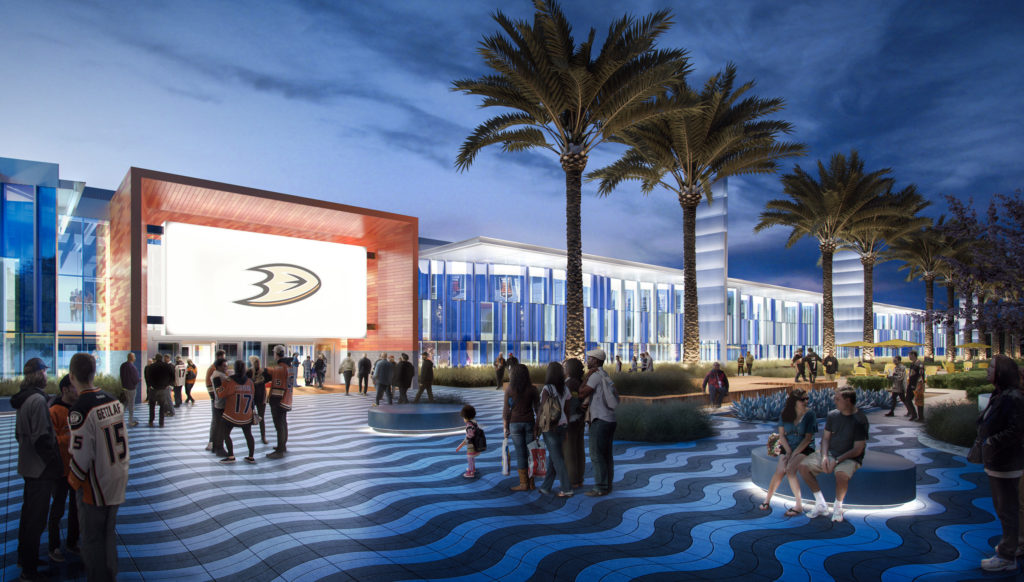
With the opening of Great Park Ice & FivePoint Arena, the $110-million facility accomplished two goals for Ducks co-owners Susan and Henry Samueli. Not only was the Irvine, CA venue designed to provide training space for the NHL’s Anaheim Ducks, but also to serve larger community purposes.
In recent years, there have been a flux of NHL organizations attempting to broaden the scope of practice facilities to accommodate community uses. Whether it is those that have recently opened—such as the Vegas Golden Knights’ City National Arena or the Minnesota Wild’s TRIA Rink—or those in development like the future Seattle Ice Centre, the increasing emphasis for NHL organizations has been to ensure that these facilities offer more than training space and include amenities that are open to the public.
For Ducks co-owners Susan and Henry Samueli, the larger goal in planning Great Park Ice was to create a space that would help grow ice sports in Southern California, something that project officials kept in mind while planning the facility.
“At the highest level, it was about bringing ice sports to Southern California,” said Steven Flanagan, Principal in charge of the project for the Irvine-based LPA design firm. “The Samuelis have a passion obviously for ice sports, being that they own the Anaheim Ducks, and they were going to pay for this facility and put aside an endowment to be able to run and operate the facility for the next 50 years.”
Built as a 280,000-square-foot community center, Great Park Ice features four rinks, including three designed to NHL standards—one in the 2,500-seat FivePoint Arena—and a fourth to Olympic standards that will serve as a training facility for the U.S. Figure Skating team. Financing for the project came from the Irvine Ice Foundation—created by the Samuelis—which will operate the facility for 50 years before ownership reverts to the City of Irvine.
Tied into the complex are several distinct design elements. Outside the facility is a palm-tree lined walkway and a 35,000-square foot beach with boardwalk made from IPE wood, an amphitheater, grand lawn, plus a terrace. The facility’s façade is characterized by glass with silver fins, giving it a distinct look.

“It’s something that’s a little different for ice facilities,” Flanagan said. “Most ice facilities are very, very solid boxes, which have a parking lot that slams right up to it, and then you get out of your car, get inside, and start ice skating. This was going to be something different, where we had this social corridor.”
Great Park Ice was built with two pre-engineered metal buildings, connected with a conventional structural system that features amenities such as the lobby, dryland training, and offices. Using this method, it became achievable to deliver the project on a faster schedule without compromising the quality, according to Flanagan.
“We wanted to deliver something very fast. We wanted one of the best facilities, but also be very mindful of the budget, so we’re always look at what’s the most economical and efficient way to do this without compromising on the quality,” he said. “So, we started talking about designers building with a pre-engineered metal building system, where the ice rinks were enclosed in an insulated metal box. There are two big pre-engineered metal buildings that are sitting on site, and then they’re connected and interlaced with a conventional structural system. This is interlaced and interwoven, and it’s something that by incorporating the pre-engineered metal building allowed us to bring it to market faster.”
While some work on the site remains and is not expected to wrap up until this summer, the building managed to celebrate its grand opening on March 7 through a fairly efficient process (LPA interviewed for the project in March 2016, according to Flanagan). For that, Flanagan credits the other firms involved in the project—including general contractor Swinnerton Builders, program and construction manager Griffin Structures, and LPA consultants 292 Design Group (ice facilities design consultant), Nelson Rudie & Associates (mechanical engineering and plumbing design), TK1SC (electric engineering), and B32 Engineering (ice system engineering).
Also vital to the process, according to Flanagan, were several Ducks organization officials, including Ducks CEO Michael Schulman, Ducks CFO Bill Foltz, and Art Trottier, VP of The Rinks.
“Art Trottier was our connection and participated in virtually every meeting from the very beginning to the very end,” Flanagan said. “We also had Bill Foltz and Michael Schulman, who were engaged at the milestone phases and provided valuable input and direction. Art was really the man who worked with us day in and day out and made most of the design decisions if not all, and really helped us be successful. Really, you can’t ask as a design professional for a better partner than H&S Ventures and the Ducks family.”
Aside from its features, one notable component of Great Park Ice is how it is positioned for environmental sustainability. It is certified LEED Silver and exceeds California Title 24 standards.
The energy efficiency, connection to the larger Great Park, role of the Irvine Ice Foundation, and the ice facilities were part of the broader goal of the Samuelis to make Great Park Ice & FivePoint Arena a focal point for the community. Ultimately, it is one that Flanagan feels drove the project to its final form.
“Their goal is not to make a profit, but to run an operation that’s self-sustaining,” he said. “In the end, it was about bringing ice to Southern California and then, as the project grew, it was about creating something that was more than just ice—a community focal point, and something that gives back to the Great Park.”
Images and renderings courtesy LPA.
This article originally appeared in the weekly Arena Digest newsletter. Are you a subscriber? Click here to sign up for the free weekly newsletter

